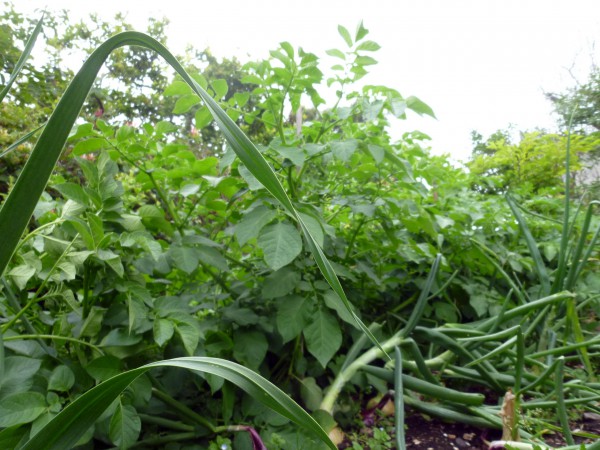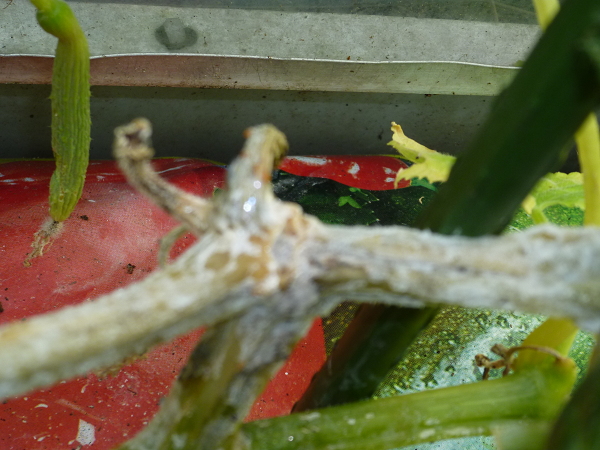 Welcome back to the summerhouse, dear readers. The weather in August has been a distinct improvement over July with a lot of growth and ripening crops. In the greenhouse tomatoes are ripening every day giving plenty to use in the kitchen. My courgette, tomato and rice soup proved a winner and I am building up bonus points which will stand me in good stead when I forget myself and wander into the house with muddy boots leaving footprints all over the carpet or leaving smelly gardening gloves in the kitchen.
Welcome back to the summerhouse, dear readers. The weather in August has been a distinct improvement over July with a lot of growth and ripening crops. In the greenhouse tomatoes are ripening every day giving plenty to use in the kitchen. My courgette, tomato and rice soup proved a winner and I am building up bonus points which will stand me in good stead when I forget myself and wander into the house with muddy boots leaving footprints all over the carpet or leaving smelly gardening gloves in the kitchen.
In the Garden
Beans

The broad beans are gone now and as they are of the legume family (which includes peas) they developed nodules on the roots which contained nitrogen. I have returned the nodules to the ground as they will benefit the next crop. The plants collect nitrogen from the air and store it in their roots. When I cut the plants down I found a lot of beans which I had missed at my last picking but as some were as tough as old boots they were not fit for the dining table. They were not wasted as I made a surprisingly tasty broad bean and red pepper soup which gained me further bonus points. So good I made a further batch of soup for freezing the next day.
I will now lightly dig this area and apply some chicken manure pellets before planting my Autumn onion sets, shallots and garlic. A word of warning here, never apply fresh chicken manure to your plot as this will burn the roots of anything you plant.
Dwarf french beans
I was complaining about how poor these were this year but the better August weather has revived them and I am harvesting them again.
Runner beans
While not quite at the picking stage, plenty of beans are now forming and I will give them a liquid feed to encourage them along.
Potatoes
My wife keeps asking “When will we be getting some potatoes?” I can’t tell her as the shaws are still green and showing no signs of dying back. I am confident, however, that we will get our first boiling next month. I always feel the wait is too long when I plant only late varieties.
Parsley
In my blog of 5 August I said it would take at least 3 weeks for the seed to germinate. Wrong!!! Seedlings started appearing after 15 days, quite the fastest germination I can remember. All conditions must have been just right for this to happen.
Dahlias

In the open garden one of my favourite flowers is the dahlia. It is excellent for garden display and as a cut flower. The sheer number of different varieties, colour and shapes continue to fascinate me. There are over 1600 varieties to be seen at the National Dahlia Selection. A particular favourite of mine is Eastwood Moonlight, a medium semi- cactus variety. Its yellow colour seems to grow more intense as dusk approaches giving it a lovely luminous quality.
Spring Bulbs
I love seeing a colourful display of Spring flowers in a garden, ranging from the snowdrop and crocus to the daffodil and tulip. There are of course many more. I have just ordered my bulbs on line from Parkers but if you are interested in a more exclusive selection try Bloms. I will plant my bulbs in containers in October and place them in a sheltered spot behind the summerhouse. Next year when there is 2 – 3 inches of growth visible I will place them in bare patches in the garden to give a display throughout Spring. When flowering is over I will plant them in parts of the garden where I would like to see them the following year.
“Why”, I hear you ask,” do you not just plant them in the garden in October?” The answer is simple; in October I will have no idea where bulbs from previous years are going to appear so to avoid damaging them while digging I plant my new bulbs in containers. This also means I can move the containers around while the bulbs are blooming to get the most pleasing display.
In the greenhouse
Tomatoes
Frogs and toads live in or under my gro-bags and we get along pretty well together. The other day while I was watering a frog leapt out and sat staring at me. I was reminded of some years ago when I got a similar fright. At that time I was visiting the wonderful Maggie’s Centre in Dundee and taking part in creative writing sessions. I was inspired to write a poem about the frog which is just a bit of fun and may not be for the purist but it still amuses me. I hope you do not mind me sharing it with you. For those of you who do not grow tomatoes, Ailsa Craig and Alicante are both varieties of tomato.

Paddy the Puddock in my Greenhouse
I found him one May morning
The grass was wet with dew
In my greenhouse I was working
On that day the clouds were few.
I saw him in a corner watching me in fear
Coloured yellow, brown and golden green
With a mouth that stretched from ear to ear
On his head two black eyes were so keen
We worked well together all that Summer
Between Alicante and Ailsa Craig too
He patrolled the tomato beds like a US Army Hummer
Eating the beasties and slugs until his belly was fu’
A dish of water was always there for him
To prevent his skin from dehydrating
I kept it filled up to the brim
Paddy fairly enjoyed the bathing
It was after sunset one August night
When I stepped across the greenhouse door
A rotten tomato made me skite
I landed on Paddy and squashed him to the floor
It is sad but Paddy has gone now
He’s gone where the good puddocks go
Diving and swimming in that great pond in the sky
I may meet him one day in that garden on high.06/08
Problems
Tomatoes can be affected by blossom end rot and while I have not been troubled so far this year I did have this problem last year. Affected plants are easily identified by the dark colouring on the bottom of the tomato. This is not a disease just a deficiency, usually caused by dry conditions which prevent the plant taking up calcium. Regular watering and a liquid feed should ensure that later fruit is unaffected.
Other matters
This experiment continues with the Tomorite treated courgettes excelling by 2.8 kg to 1.4kg of fruit but as I said before their situations are not identical. If I repeat the experiment next year I will swap them round.
The Tomorite treated tomatoes look healthier and more robust and while they have been later in ripening there seems to be a larger crop. I will report in more detail in my next blog. I have been giving my outdoor pot plants a regular feed of the Comfrey/nettle mixture and the results have been promising with good strong growth and a good number of blooms.

Sarah, who we are helping with this experiment and will be analyzing the teabags, has posted this collage of participants. It was my intention to have a competition to see if anyone could identify me with a prize for the first correct entry. However, I decided it would be unfair to the readers who do not know me. Suffice to say you will find me if you look for a hat!
Thank you for reading my tale and please feel free to leave a comment.
Enjoy your garden.












